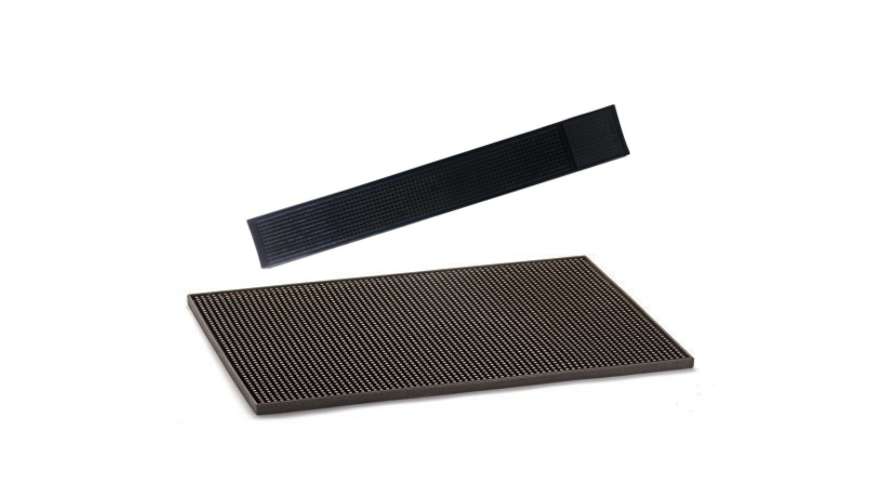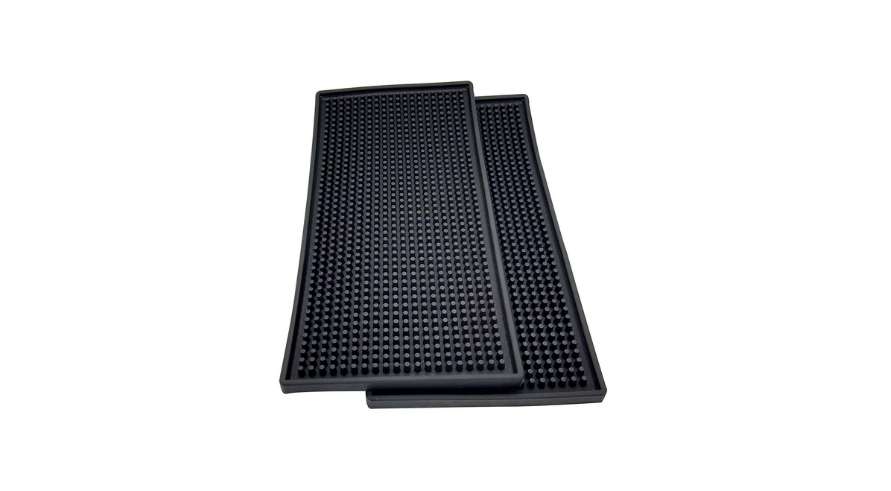1. What are bar mats, and what do they do?
Bar mats are a typical piece of bar equipment designed to dress up the bar’s surface and catch drips when pouring drinks. They can be divided into two kinds of mats: the rail mat and the service mat.
Rail mats are long and are placed on the edge of the bar. Bartenders mix drinks on them. These rail mats can hold an adequate amount of liquid, preventing overflow by dispersing the liquid across its surface. No more wet bars.

Service mats do the same, but they’re placed on the service bar. These cushions are bigger than a rail mat because they are designed for large drink orders and wine service.

All bar mats are three-dimensional surfaces, so they are easy to clean and air-dry quickly. What you place on them never gets wet by the liquid that drips into them. They are designed in a variety of shapes and are often emblazoned with company logos.
Restaurants and bars love their bar mats for their efficiency and reliability, but customers enjoy them too; they’re part of the establishment’s décor. Smart bar owners have found in these nicely designed pieces of equipment the perfect gift for their cherished customers and can even represent an additional income source.
It’s easy to see that a bar mat from a notorious establishment is a collector’s item, especially for its unique engraved logo. This approach not only increases customer satisfaction but also indirectly allows guests to promote the business in their own home bars with friends and family.
Now, it’s not only bar owners who buy bar mats. With the rise of the COVID-19 pandemic and its social restrictions came the trend of putting together your home bar. Wine lovers, beer drinkers, whiskey aficionados and cocktail enthusiasts found outstanding value on personalized bars, ones you can design yourself with your preferred logo.
2. How many kinds of bar mats are there?
There are three common materials to make bar mats. Allow me to introduce them to to.
2.1. Rubber Bar Mat
The rubber bar mat is made of natural rubber and it’s based on a polymer. The rubber is deformed by zigzag extrusion and recovers quickly, meaning it has good chemical stability and mechanical properties.

2.2. Silicone Bar Mat
The silicone bar mat has a strong safety performance. Its main component is silicon dioxide, and its properties are reliably stable. These mats have a strong absorption capacity and are non-toxic and harmless. With time, their absorption capacity decreases, but they can be regenerated, guaranteeing a long life. They’re also beautiful to the touch.

2.3. PVC Bar Mat
PVC bar mats are mainly made of PVC powder (polyvinyl chloride), oil and color paste mixed into raw materials, heated and cooled by a modern micro injection dripping process.

3. Rubber bar mat, Silicone bar mat, Plastic bar mat, which should I go for?
I can’t answer this for you. Each material has its advantages and disadvantages, so let’s take a closer look at them to help you make the right choice.
3.1. Rubber Bar Mat
Advantages:
- Rubber bar mats have excellent resistance to high and low temperatures and maintain good elasticity in the temperature range of -20 – 120 degrees.
- Rubber bar mats are also flame retardant, electrically isolated, wear-resistant, and ozone resistant, to mention a few benefits.
Disadvantages:
- Rubber mats tend to age faster than ones made with other materials; they aren’t oil resistant, chemical resistant (except alkali) and their average performance is not great.
- Since rubber’s texture is quite different from silicone and PVC; they are made with their own technology, including a different style of branding and design. You need to use non-woven fabrics to draw the brand logo and patterns, rather than dispensing technology, as we do with silicone bar mats and PVC bar mats. Therefore, the rubber bar mat is not waterproof, and the non-woven fabric will eventually absorb liquid.
3.2. Silicone Bar Mat
Advantages:
- High reliability, high compressibility, softness and elasticity.
- Natural stickiness, no need for additional surface adhesive.
- Anti-skid, shockproof, impervious to water, heat-insulated, long-living logos that don’t fade easily, and easy to clean.
- Durable, effectively protect the surface of the bar from burns and scratches.
- Temperature resistant between -40 – 250 degrees Celsius. Resistant to baking and freezing and will remain soft and undeformed.
- Environmentally safe, non-toxic and tasteless, certified by FDA, ROHS, SGS, LFGB and other environmental organizations. These bar mats are food-friendly.
Disadvantages:
- The price is higher compared to other materials, and the production method is complicated.
- Because of silicone’s natural adhesive texture, they can gather dust.
3.3. PVC Bar Mat
Advantages:
- PVC bar mats are non-flammable, wear-resistant, chemical corrosion resistant, and have low gas and water vapor leakage.
- PVC bar mats offer electrical insulation, heat insulation, noise elimination and shock absorption, amongst many other benefits. The price ratio is superior compared to rubber and silicone mats.
Disadvantages:
- Thermal stability and impact resistance are lower than other alternatives. After extended use and temperature variation, they can experience brittleness.
- This material is challenging to decompress, causing a higher environmental impact.
Conclusion:
With the information above, you can make educated decisions about the right bar mats for your needs. Chances are you still have some questions, so read on the most asked questions by our customers.
4. What basic information should I know about bar mats?
4.1. What is the weight and size of a regular bar mat?
Bar mats don’t have specific sizes because all bars are different. The size is up to you. Personalize length, width and height to suit your needs. Having said that, some measures are more popular than others and are becoming a standard. We’ll talk about them later.
4.2. How much does a bar mat cost?
The price of bar mat varies depending on its size, but also the supplier. Here’s a current industry comparison between Amazon, the leading online retail store, and our manufacturers’ prices.
Amazon:
PVC bar mat & Rubber bar mat: $6~$8
Silicone bar mat: $12~$15

EverStar:
PVC bar mat & Rubber bar mat: $2~$4
Silicone bar mat: $4~$8
4.3. How often should I change my bar mats?
Generally, bar mats’ lifespan ranges between 3-5 years without suffering noticeable damage. Still, 80% of our customers buy once or twice a year. The remaining 20% repurchase their bar mats at least once every two years.
Like purchasing clothes, there’s no rule behind how often you should replace your mar mats. It’s all up to you, your establishment’s policies and marketing efforts.
At EverStar, we focus on manufacturing and delivering the highest-quality, most durable bar mats, even if that impacts our sales by volume.
We’re all about quality, not quantity, and a satisfied customer is more important for us than disappointed customers that need to replace their lower-quality bar mats more often. Having said that, bar mats are part of your establishment’s image, so you might want to keep them in prime condition.
Changing the color, the branding and the style of your bar mats are an excellent way of keeping customers interested. Within such a competitive environment, it’s only natural that you want your bar to look its best at all times.
At EverStar, we’re more than bar mat manufacturers; we’re your professional bar mat advisors and can help you with any questions; we can provide design and ideas to make the most out of your purchase.
4.4. How should I store my bar mats when unused?
Bar mats don’t need any special treatment or storage conditions. Store them in a room temperature warehouse when not in use.
5. How are bar mats manufactured?
Rubber, Silicone and PVC bar mats require a unique production method. Please read our posts on the PVC bar mat making process and Natural rubber bar mat making process if you want to dig deeper into the manufacturing process.
6. What things should I consider before buying bar mats from China?
6.1. Make a budget.
There’s no doubt buying your bar mats directly from a manufacturer in China is cost-effective, especially compared to the alternatives online. Before getting started, make a spending budget depending on your businesses’ needs. Consider the number of units you’ll need too. You can use the prices mentioned above to calculate an estimate.
6.2. Determine your design.
If you want personalized bar mats, make sure you have your logo designed. Even if it’s not the final logo, it will help if you already have an idea of the size, style and color. We’re happy to help you with the design process free of charge.
6.3. Looking for a supplier.
Once you have a budget, you know how many bar mats you need and have a design, choose your supplier. As industry leaders, we’ll be more than happy to help you meet your bar mat requirements, but if you want to look for other alternatives, make sure the bar supplier covers the following three characteristics:
- The bar mat’s quality is on par with the world standards, and they use high-quality materials.
- The price of the bar mat is on par with the quality. Bar mats manufactured in China are relatively cheap, but they also need to be well priced for what you receive.
- The supplier is honest. If there’s insufficient information or lousy communication, be careful. Some people might want to take advantage of the customers’ lack of knowledge.
Trying to keep this post purely informative, I’ll keep our small advertisement short and concise.
Don’t buy your bar mats with retailers, Amazon or other bar suppliers; buy them directly from the producers; it’s just as easy, the communication is better, and the results are guaranteed.
Most people think that they need to order large quantities to purchase their bar mats from the manufacturer, making small wineries and boutique pubs and bars believe they can’t afford it.
Since we’re manufacturers, we can accommodate our production for as little as 100 fully personalized bar mats, design included. Please contact me at [email protected] and let me help you find the right solution for you.
7. How much can I customize my bar mats?
With Everest, the sky’s the limit! We custom-make the molds for your bar mats, and we can manufacture them as big or small as you need. We can cover your bar’s entire surface if that’s what you want! You can also customize the shape and color to match your bar’s identity, and you can choose a pattern and add your logo, slogan or any text you want.
8. How do I clean a bar mat?
All bar mats are waterproof, so it doesn’t matter if they’re made of silicone, rubber or PVC, wash them and rinse them with water without risking any damage. Follow this link for detailed instructions for cleaning a bar mat.
9. How do I test the quality of a bar mat?
Poor quality bar mats are usually recognizable because:
- The bar mat peg is incomplete.

- The bar mat logo is stained.

- The bottom of the bar mat is uneven.

- The bar mat was charred.



- There are bubbles at the bottom of the bar mat.

- When bending the bar mat, it is easily damaged.
- The color of the bar mat is not faithful (including logo and pattern).
10. How is the bar mat packed before shipment?
After making your bar mats, we safely pack them in OPP bags and then inside 10 or 25-piece cartons. Then we ship them right to your door step!
These were the most common questions about our custom-made bar mats. If we haven’t covered all your doubts, please leave a quick comment below and we’ll get back to you!

